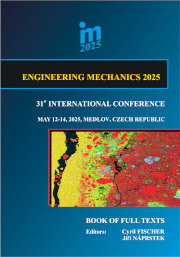Proceedings Vol. 31 (2025)

ENGINEERING MECHANICS 2025
May 12 – 14, 2025, Medlov, Czech Republic
All papers were reviewed by members of the scientific committee.
ISBN 978-80-86246-99-4 (electronic)
ISSN 1805-8248 (printed)
ISSN 1805-8256 (electronic)
scientific committee — home
Chapter 4: Fluid Mechanics and Computational Fluid Dynamics
The growing interest in microelectromechanical systems (MEMS) technologies is driving research in this area. One of the important elements used in MEMS technologies are micropumps. Most often, micropumps have an integrated membrane made of different materials that is directly affected by the excitation source. In this work, the membrane is integrated into the housing (made of the same material) and is separated from the excitation source. This reduces the complexity of production and the number of parts to be assembled. Finite element analysis has shown that this type of micropump works and can achieve a performance of 1.25 µl/s. In addition, it is planned to improve the geometry, mathematical model, and manufacturing technology of the micropump to increase the micropump performance.
Many flows in nature and technical applications are quasi-two-dimensional. This means that one dimension is significantly shorter than the other two. Examples include atmospheric and oceanic circulation, flow between the fins of a cooler, and protoplanetary discs. The two-dimensionality leads to an inverse energy cascade, pumping energy from small scales towards larger ones. This effect, predicted by Kraichnan, leads to the formation of a large-scale energy condensate. We performed a simple experimental study of decaying grid turbulence clamped by boundary layers. We observed that the large-scale condensate appears when the layer thickness is comparable to the mesh parameter of the grid. In contrast to an ideal inviscid case, the condensate weakens with thinner layers. We explain this as the effect of boundary layers, which dissipate energy at large scales and, on the other hand, pump small-scale structures (e.g., hairpin vortices) into the main flow.
This article compares the efficiency of three selected hydraulic sources: a fixed displacement pump with a relief valve, a pressure compensated pump, and a pump with Load-Sensing control. The study investigates how pump speed reduction impacts the efficiency of each source. An experimental circuit was used to measure input power and output power, evaluating efficiency across varying flow rates and pressure drops. The analysis determines which hydraulic source exhibits the highest efficiency and whether efficiency gains from speed reduction are consistent across different loads.
Quartz Crystal Microbalance (QCM) biosensors are often used for the rapid detection of pathogens, for example, in drinking water. The pathogens are caught by antibodies attached to the crystal surface, leading to an increase in the attached mass and a subsequent change in the crystal resonant frequency. However, in the standard geometry configuration, most pathogens are caught in areas with limited crystal sensitivity. In our previous study, we numerically investigated the effect of geometry changes on pathogen detection efficiency. In particular, obstacles were added on the top non-detecting wall of the biosensor cell to channel the flow with pathogens. In this work, we follow up on the achieved results and conduct a parametric study focusing on tuning the previously found best obstacle layouts. With the tuned parameters, a further increase in the detection efficiency was observed.
The significant distortion of wind tunnel data may occur, when the boundary layer of the tunnel wall interacts and modifies the flow around the tested object. To numerically evaluate the influence of this blockage effect on aerodynamic coefficients, 2D RANS simulations of airflow around porous and non-porous U-profiles in two computational domains with varying distances between the top and bottom walls were carried out. Another factor investigated in relation to aerodynamic characteristics was the turbulence intensity of the inlet stream. Simulations of the U-profile at various impact angles, using two differently sized computational domains and two levels of turbulent intensity, were performed. The mean drag and lift coefficients, fluctuating lift coefficient, and Strouhal number were evaluated.
This study presents the results of wind tunnel experiments on U-shaped beams with either solid flanges or flanges with 50% porosity. Aerodynamic drag and lift coefficients, along with pressure coefficient distributions on the beam surfaces, were evaluated and compared for both configurations. The findings demonstrate that flange porosity significantly affects the aerodynamic forces and flow around the U-beam. Across most angles of attack, the solid-flange beam exhibited higher drag than the porous-flange beam. However, within the range of approximately −11.5° to −5.5°, the porous configuration showed higher drag. Furthermore, at negative angles of attack, the lift force on the porous-flanged beam acted in the opposite direction to that on the solid-flanged beam. Finally, incorporating flange porosity reduced the magnitude of suction pressures on both the top and bottom surfaces of the U-beam.
Different models of u-beams with porous flanges were tested in wind tunnel with the use of force and moment measurements. Due to high wind tunnel blockage ratio, the wind tunnel blockage corrections were applied to the measured forces and moments. The tested model beams were manufactured in two scales, i. e. large model and small model with half dimensions of the large model in order to test Reynolds number independence. Different blockage ratio calculation methods were used on the large and small U-beam model across various wind attack angles. The Maskell blockage correction method was applied to the experimental drag coefficient data.
Copyright © 2025 Institute of Theoretical and Applied Mechanics, Czech Academy of Sciences, Prague
All contributions are published under the Creative Commons Attribution 4.0 International License (CC BY 4.0). The copyright remains with the authors. The texts are publicly accessible, and any reuse must include appropriate credit to the original source as required by the license.
